Strategic Marketing Analysis for Travel and Tourism Businesses
VerifiedAdded on 2020/02/05
|18
|6443
|168
Report
AI Summary
This report provides a comprehensive analysis of marketing principles within the travel and tourism sector. It begins by discussing core marketing concepts, including understanding consumer needs, wants, and demands, and the importance of branding. The report then assesses the impact of the marketing environment, utilizing a SCEPTIC analysis to evaluate political, economic, social, cultural, physical, technological, international, communication, administrative, and legal factors affecting tourism businesses and destinations. It explores factors influencing consumer motivation and demand, such as price, economic conditions, demographics, and media influence. Furthermore, the report delves into market segmentation principles, emphasizing the importance of understanding consumer behavior and tailoring marketing strategies accordingly. The second part of the report focuses on the role of marketing as a management tool, highlighting the importance of strategic marketing planning and the use of market research and information in decision-making. It also touches on the influence of marketing on society. The report concludes by examining the marketing mix elements, including product, price, place, and promotion, and their application to the tourism sector. The report uses examples of specific destinations like Denmark, Amsterdam, Lisbon, and Porto to illustrate key concepts and strategies.
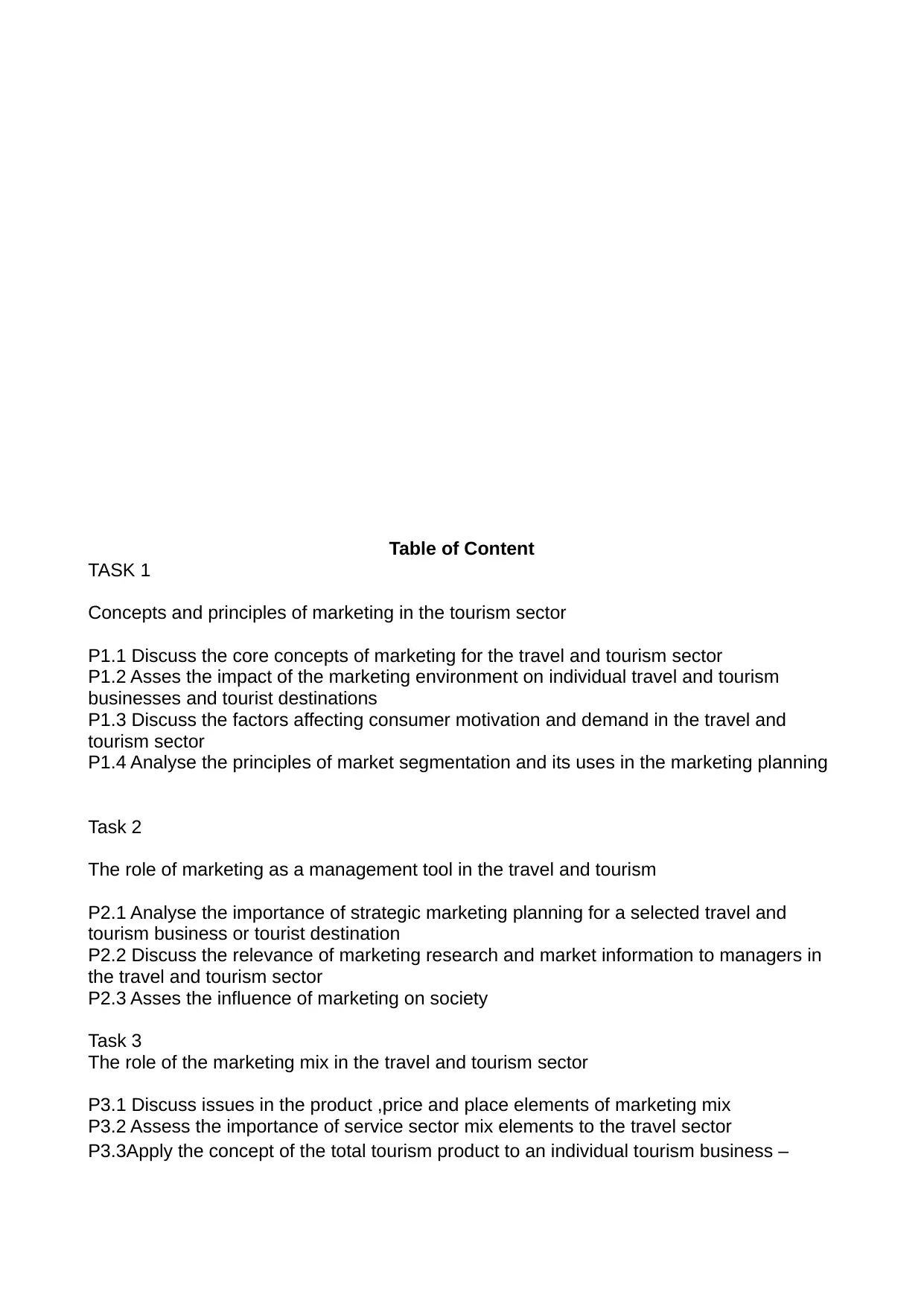
Table of Content
TASK 1
Concepts and principles of marketing in the tourism sector
P1.1 Discuss the core concepts of marketing for the travel and tourism sector
P1.2 Asses the impact of the marketing environment on individual travel and tourism
businesses and tourist destinations
P1.3 Discuss the factors affecting consumer motivation and demand in the travel and
tourism sector
P1.4 Analyse the principles of market segmentation and its uses in the marketing planning
Task 2
The role of marketing as a management tool in the travel and tourism
P2.1 Analyse the importance of strategic marketing planning for a selected travel and
tourism business or tourist destination
P2.2 Discuss the relevance of marketing research and market information to managers in
the travel and tourism sector
P2.3 Asses the influence of marketing on society
Task 3
The role of the marketing mix in the travel and tourism sector
P3.1 Discuss issues in the product ,price and place elements of marketing mix
P3.2 Assess the importance of service sector mix elements to the travel sector
P3.3Apply the concept of the total tourism product to an individual tourism business –
TASK 1
Concepts and principles of marketing in the tourism sector
P1.1 Discuss the core concepts of marketing for the travel and tourism sector
P1.2 Asses the impact of the marketing environment on individual travel and tourism
businesses and tourist destinations
P1.3 Discuss the factors affecting consumer motivation and demand in the travel and
tourism sector
P1.4 Analyse the principles of market segmentation and its uses in the marketing planning
Task 2
The role of marketing as a management tool in the travel and tourism
P2.1 Analyse the importance of strategic marketing planning for a selected travel and
tourism business or tourist destination
P2.2 Discuss the relevance of marketing research and market information to managers in
the travel and tourism sector
P2.3 Asses the influence of marketing on society
Task 3
The role of the marketing mix in the travel and tourism sector
P3.1 Discuss issues in the product ,price and place elements of marketing mix
P3.2 Assess the importance of service sector mix elements to the travel sector
P3.3Apply the concept of the total tourism product to an individual tourism business –
Paraphrase This Document
Need a fresh take? Get an instant paraphrase of this document with our AI Paraphraser
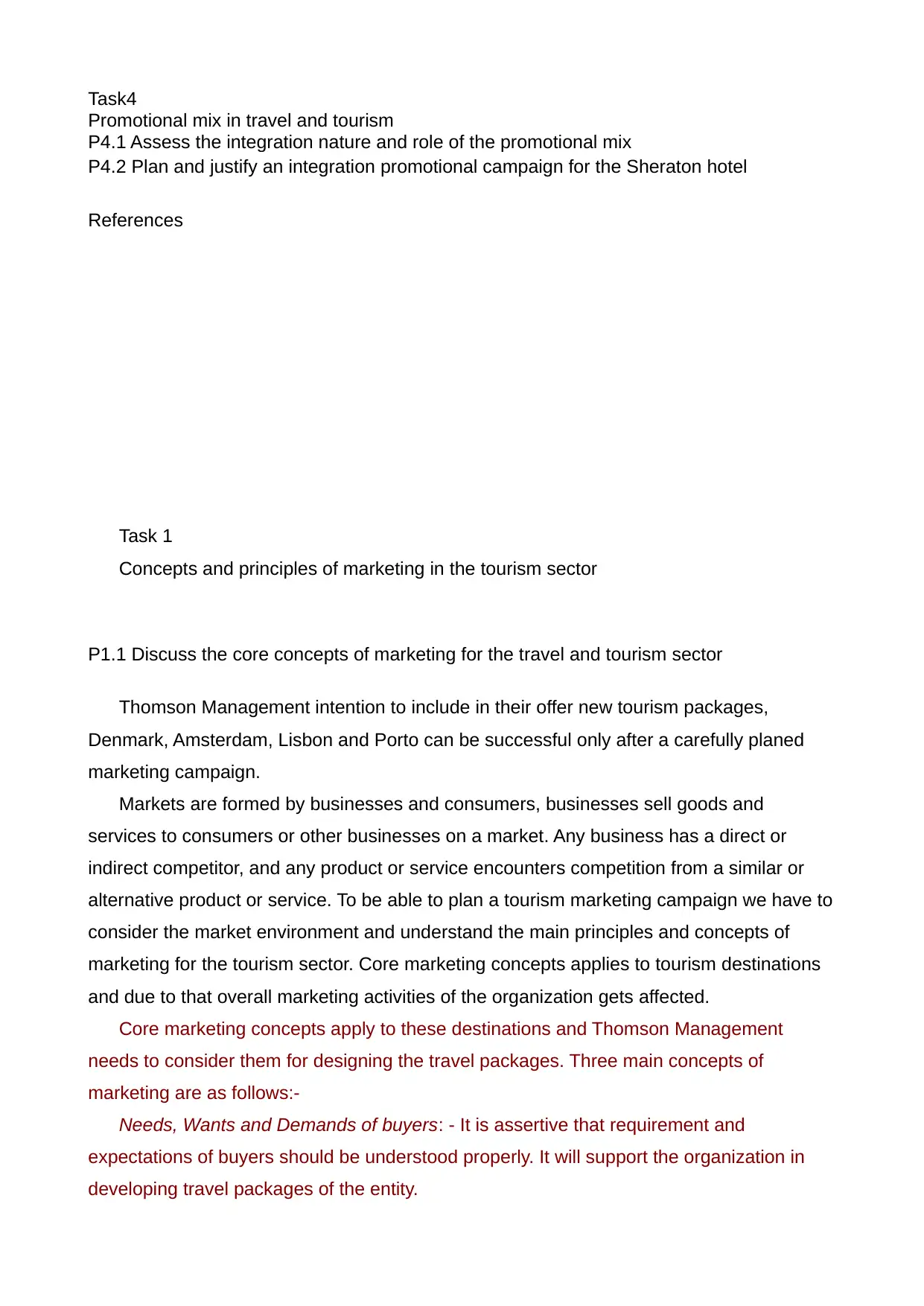
Task4
Promotional mix in travel and tourism
P4.1 Assess the integration nature and role of the promotional mix
P4.2 Plan and justify an integration promotional campaign for the Sheraton hotel
References
Task 1
Concepts and principles of marketing in the tourism sector
P1.1 Discuss the core concepts of marketing for the travel and tourism sector
Thomson Management intention to include in their offer new tourism packages,
Denmark, Amsterdam, Lisbon and Porto can be successful only after a carefully planed
marketing campaign.
Markets are formed by businesses and consumers, businesses sell goods and
services to consumers or other businesses on a market. Any business has a direct or
indirect competitor, and any product or service encounters competition from a similar or
alternative product or service. To be able to plan a tourism marketing campaign we have to
consider the market environment and understand the main principles and concepts of
marketing for the tourism sector. Core marketing concepts applies to tourism destinations
and due to that overall marketing activities of the organization gets affected.
Core marketing concepts apply to these destinations and Thomson Management
needs to consider them for designing the travel packages. Three main concepts of
marketing are as follows:-
Needs, Wants and Demands of buyers: - It is assertive that requirement and
expectations of buyers should be understood properly. It will support the organization in
developing travel packages of the entity.
Promotional mix in travel and tourism
P4.1 Assess the integration nature and role of the promotional mix
P4.2 Plan and justify an integration promotional campaign for the Sheraton hotel
References
Task 1
Concepts and principles of marketing in the tourism sector
P1.1 Discuss the core concepts of marketing for the travel and tourism sector
Thomson Management intention to include in their offer new tourism packages,
Denmark, Amsterdam, Lisbon and Porto can be successful only after a carefully planed
marketing campaign.
Markets are formed by businesses and consumers, businesses sell goods and
services to consumers or other businesses on a market. Any business has a direct or
indirect competitor, and any product or service encounters competition from a similar or
alternative product or service. To be able to plan a tourism marketing campaign we have to
consider the market environment and understand the main principles and concepts of
marketing for the tourism sector. Core marketing concepts applies to tourism destinations
and due to that overall marketing activities of the organization gets affected.
Core marketing concepts apply to these destinations and Thomson Management
needs to consider them for designing the travel packages. Three main concepts of
marketing are as follows:-
Needs, Wants and Demands of buyers: - It is assertive that requirement and
expectations of buyers should be understood properly. It will support the organization in
developing travel packages of the entity.
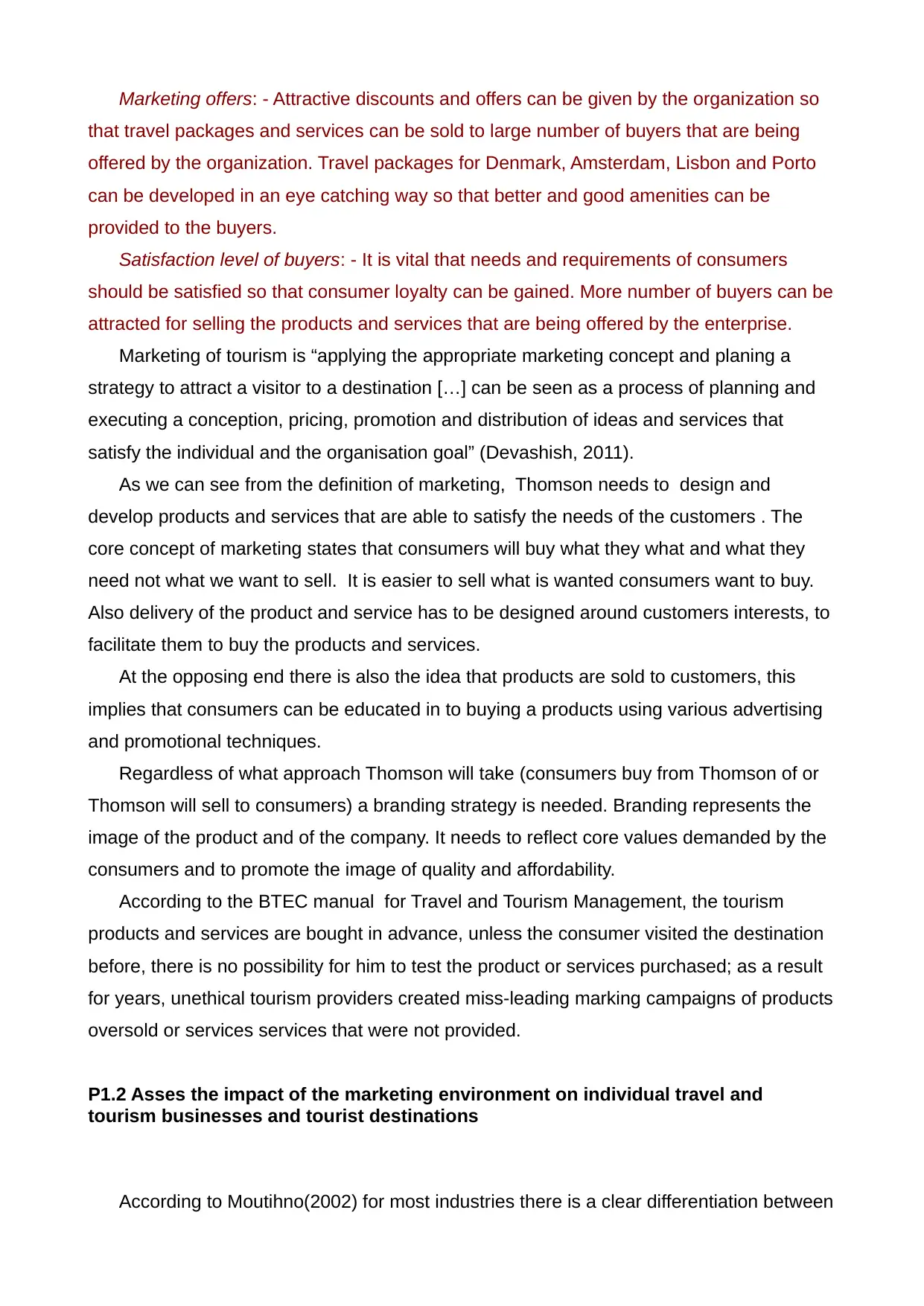
Marketing offers: - Attractive discounts and offers can be given by the organization so
that travel packages and services can be sold to large number of buyers that are being
offered by the organization. Travel packages for Denmark, Amsterdam, Lisbon and Porto
can be developed in an eye catching way so that better and good amenities can be
provided to the buyers.
Satisfaction level of buyers: - It is vital that needs and requirements of consumers
should be satisfied so that consumer loyalty can be gained. More number of buyers can be
attracted for selling the products and services that are being offered by the enterprise.
Marketing of tourism is “applying the appropriate marketing concept and planing a
strategy to attract a visitor to a destination […] can be seen as a process of planning and
executing a conception, pricing, promotion and distribution of ideas and services that
satisfy the individual and the organisation goal” (Devashish, 2011).
As we can see from the definition of marketing, Thomson needs to design and
develop products and services that are able to satisfy the needs of the customers . The
core concept of marketing states that consumers will buy what they what and what they
need not what we want to sell. It is easier to sell what is wanted consumers want to buy.
Also delivery of the product and service has to be designed around customers interests, to
facilitate them to buy the products and services.
At the opposing end there is also the idea that products are sold to customers, this
implies that consumers can be educated in to buying a products using various advertising
and promotional techniques.
Regardless of what approach Thomson will take (consumers buy from Thomson of or
Thomson will sell to consumers) a branding strategy is needed. Branding represents the
image of the product and of the company. It needs to reflect core values demanded by the
consumers and to promote the image of quality and affordability.
According to the BTEC manual for Travel and Tourism Management, the tourism
products and services are bought in advance, unless the consumer visited the destination
before, there is no possibility for him to test the product or services purchased; as a result
for years, unethical tourism providers created miss-leading marking campaigns of products
oversold or services services that were not provided.
P1.2 Asses the impact of the marketing environment on individual travel and
tourism businesses and tourist destinations
According to Moutihno(2002) for most industries there is a clear differentiation between
that travel packages and services can be sold to large number of buyers that are being
offered by the organization. Travel packages for Denmark, Amsterdam, Lisbon and Porto
can be developed in an eye catching way so that better and good amenities can be
provided to the buyers.
Satisfaction level of buyers: - It is vital that needs and requirements of consumers
should be satisfied so that consumer loyalty can be gained. More number of buyers can be
attracted for selling the products and services that are being offered by the enterprise.
Marketing of tourism is “applying the appropriate marketing concept and planing a
strategy to attract a visitor to a destination […] can be seen as a process of planning and
executing a conception, pricing, promotion and distribution of ideas and services that
satisfy the individual and the organisation goal” (Devashish, 2011).
As we can see from the definition of marketing, Thomson needs to design and
develop products and services that are able to satisfy the needs of the customers . The
core concept of marketing states that consumers will buy what they what and what they
need not what we want to sell. It is easier to sell what is wanted consumers want to buy.
Also delivery of the product and service has to be designed around customers interests, to
facilitate them to buy the products and services.
At the opposing end there is also the idea that products are sold to customers, this
implies that consumers can be educated in to buying a products using various advertising
and promotional techniques.
Regardless of what approach Thomson will take (consumers buy from Thomson of or
Thomson will sell to consumers) a branding strategy is needed. Branding represents the
image of the product and of the company. It needs to reflect core values demanded by the
consumers and to promote the image of quality and affordability.
According to the BTEC manual for Travel and Tourism Management, the tourism
products and services are bought in advance, unless the consumer visited the destination
before, there is no possibility for him to test the product or services purchased; as a result
for years, unethical tourism providers created miss-leading marking campaigns of products
oversold or services services that were not provided.
P1.2 Asses the impact of the marketing environment on individual travel and
tourism businesses and tourist destinations
According to Moutihno(2002) for most industries there is a clear differentiation between
⊘ This is a preview!⊘
Do you want full access?
Subscribe today to unlock all pages.

Trusted by 1+ million students worldwide
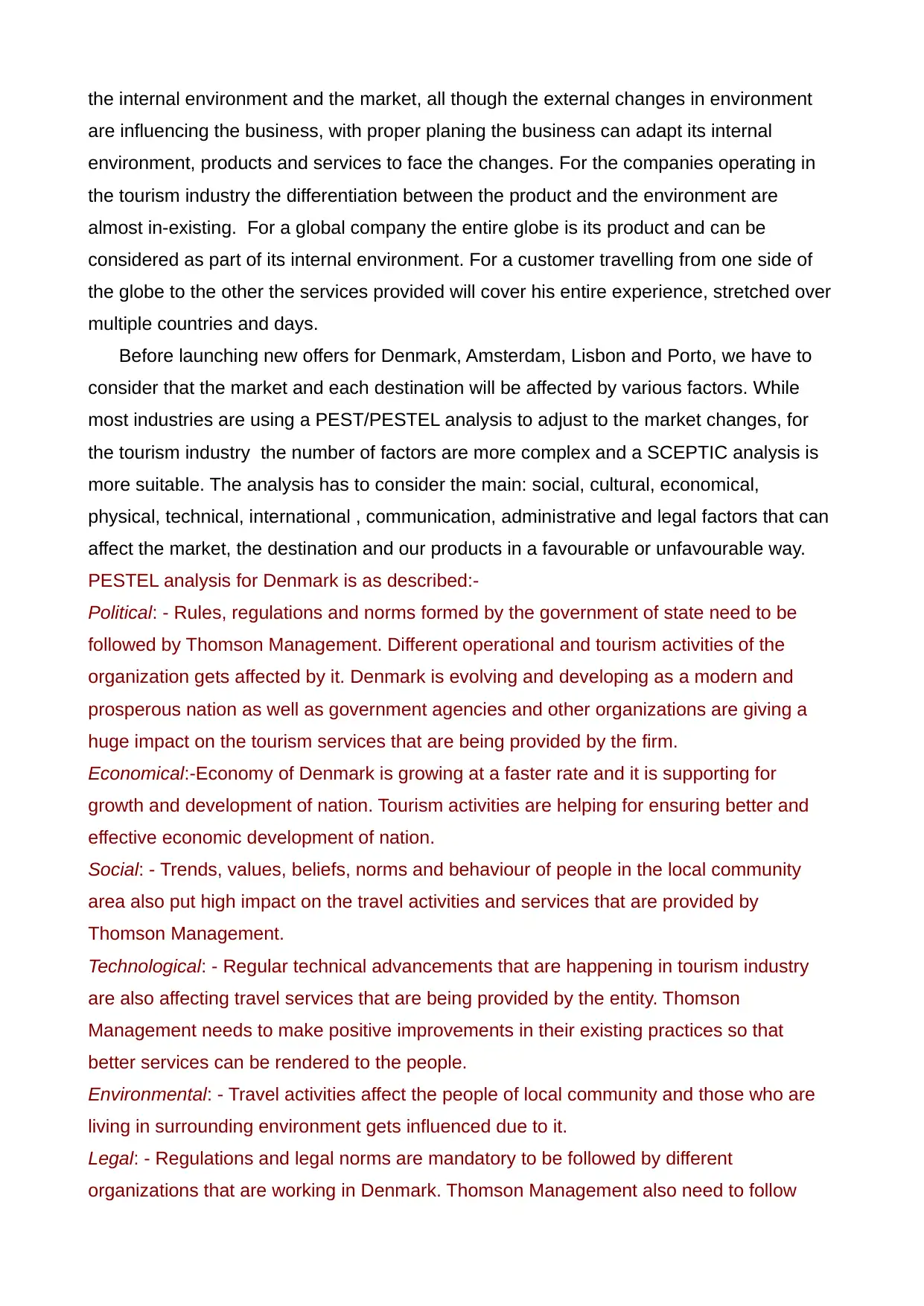
the internal environment and the market, all though the external changes in environment
are influencing the business, with proper planing the business can adapt its internal
environment, products and services to face the changes. For the companies operating in
the tourism industry the differentiation between the product and the environment are
almost in-existing. For a global company the entire globe is its product and can be
considered as part of its internal environment. For a customer travelling from one side of
the globe to the other the services provided will cover his entire experience, stretched over
multiple countries and days.
Before launching new offers for Denmark, Amsterdam, Lisbon and Porto, we have to
consider that the market and each destination will be affected by various factors. While
most industries are using a PEST/PESTEL analysis to adjust to the market changes, for
the tourism industry the number of factors are more complex and a SCEPTIC analysis is
more suitable. The analysis has to consider the main: social, cultural, economical,
physical, technical, international , communication, administrative and legal factors that can
affect the market, the destination and our products in a favourable or unfavourable way.
PESTEL analysis for Denmark is as described:-
Political: - Rules, regulations and norms formed by the government of state need to be
followed by Thomson Management. Different operational and tourism activities of the
organization gets affected by it. Denmark is evolving and developing as a modern and
prosperous nation as well as government agencies and other organizations are giving a
huge impact on the tourism services that are being provided by the firm.
Economical:-Economy of Denmark is growing at a faster rate and it is supporting for
growth and development of nation. Tourism activities are helping for ensuring better and
effective economic development of nation.
Social: - Trends, values, beliefs, norms and behaviour of people in the local community
area also put high impact on the travel activities and services that are provided by
Thomson Management.
Technological: - Regular technical advancements that are happening in tourism industry
are also affecting travel services that are being provided by the entity. Thomson
Management needs to make positive improvements in their existing practices so that
better services can be rendered to the people.
Environmental: - Travel activities affect the people of local community and those who are
living in surrounding environment gets influenced due to it.
Legal: - Regulations and legal norms are mandatory to be followed by different
organizations that are working in Denmark. Thomson Management also need to follow
are influencing the business, with proper planing the business can adapt its internal
environment, products and services to face the changes. For the companies operating in
the tourism industry the differentiation between the product and the environment are
almost in-existing. For a global company the entire globe is its product and can be
considered as part of its internal environment. For a customer travelling from one side of
the globe to the other the services provided will cover his entire experience, stretched over
multiple countries and days.
Before launching new offers for Denmark, Amsterdam, Lisbon and Porto, we have to
consider that the market and each destination will be affected by various factors. While
most industries are using a PEST/PESTEL analysis to adjust to the market changes, for
the tourism industry the number of factors are more complex and a SCEPTIC analysis is
more suitable. The analysis has to consider the main: social, cultural, economical,
physical, technical, international , communication, administrative and legal factors that can
affect the market, the destination and our products in a favourable or unfavourable way.
PESTEL analysis for Denmark is as described:-
Political: - Rules, regulations and norms formed by the government of state need to be
followed by Thomson Management. Different operational and tourism activities of the
organization gets affected by it. Denmark is evolving and developing as a modern and
prosperous nation as well as government agencies and other organizations are giving a
huge impact on the tourism services that are being provided by the firm.
Economical:-Economy of Denmark is growing at a faster rate and it is supporting for
growth and development of nation. Tourism activities are helping for ensuring better and
effective economic development of nation.
Social: - Trends, values, beliefs, norms and behaviour of people in the local community
area also put high impact on the travel activities and services that are provided by
Thomson Management.
Technological: - Regular technical advancements that are happening in tourism industry
are also affecting travel services that are being provided by the entity. Thomson
Management needs to make positive improvements in their existing practices so that
better services can be rendered to the people.
Environmental: - Travel activities affect the people of local community and those who are
living in surrounding environment gets influenced due to it.
Legal: - Regulations and legal norms are mandatory to be followed by different
organizations that are working in Denmark. Thomson Management also need to follow
Paraphrase This Document
Need a fresh take? Get an instant paraphrase of this document with our AI Paraphraser
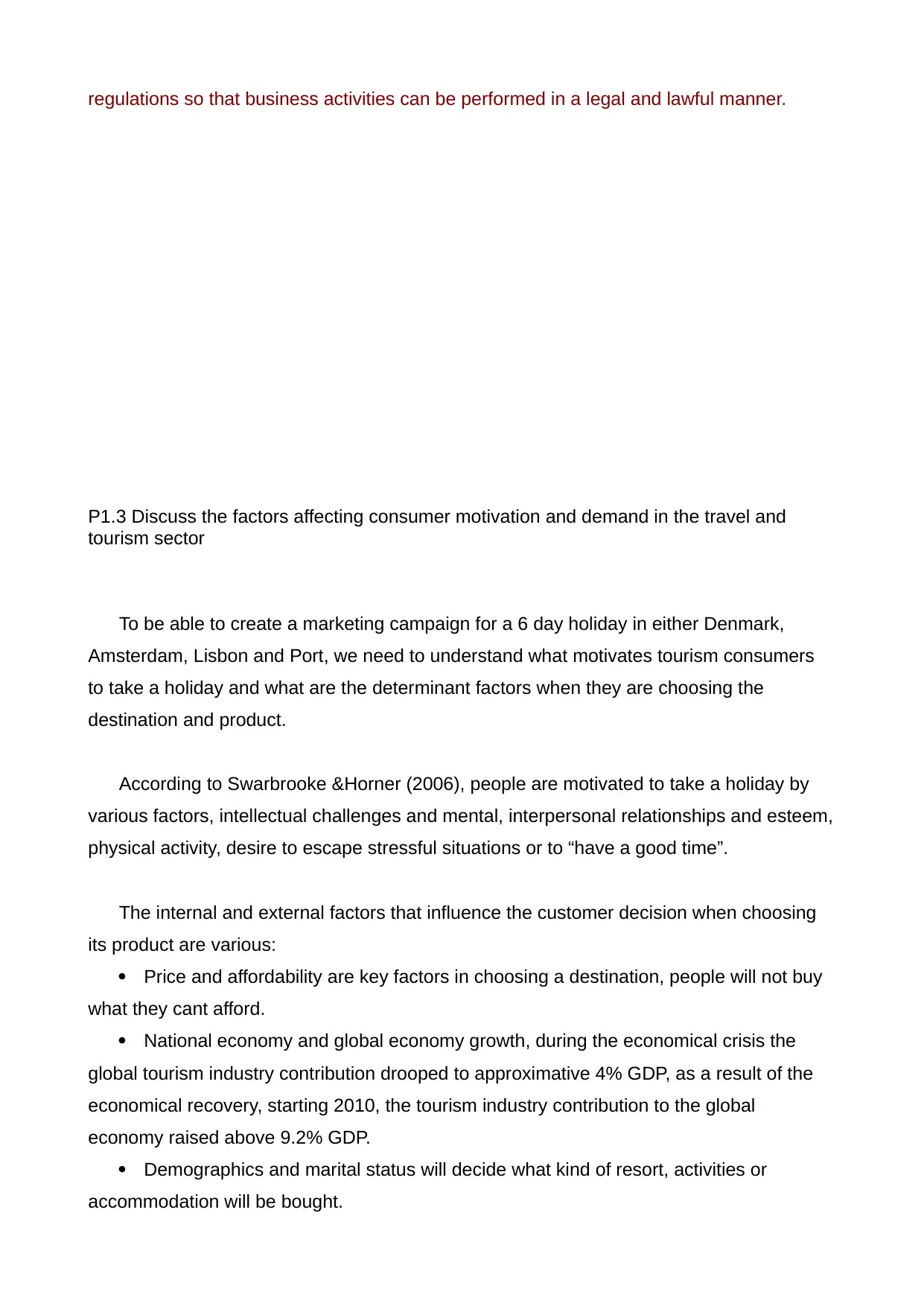
regulations so that business activities can be performed in a legal and lawful manner.
P1.3 Discuss the factors affecting consumer motivation and demand in the travel and
tourism sector
To be able to create a marketing campaign for a 6 day holiday in either Denmark,
Amsterdam, Lisbon and Port, we need to understand what motivates tourism consumers
to take a holiday and what are the determinant factors when they are choosing the
destination and product.
According to Swarbrooke &Horner (2006), people are motivated to take a holiday by
various factors, intellectual challenges and mental, interpersonal relationships and esteem,
physical activity, desire to escape stressful situations or to “have a good time”.
The internal and external factors that influence the customer decision when choosing
its product are various:
Price and affordability are key factors in choosing a destination, people will not buy
what they cant afford.
National economy and global economy growth, during the economical crisis the
global tourism industry contribution drooped to approximative 4% GDP, as a result of the
economical recovery, starting 2010, the tourism industry contribution to the global
economy raised above 9.2% GDP.
Demographics and marital status will decide what kind of resort, activities or
accommodation will be bought.
P1.3 Discuss the factors affecting consumer motivation and demand in the travel and
tourism sector
To be able to create a marketing campaign for a 6 day holiday in either Denmark,
Amsterdam, Lisbon and Port, we need to understand what motivates tourism consumers
to take a holiday and what are the determinant factors when they are choosing the
destination and product.
According to Swarbrooke &Horner (2006), people are motivated to take a holiday by
various factors, intellectual challenges and mental, interpersonal relationships and esteem,
physical activity, desire to escape stressful situations or to “have a good time”.
The internal and external factors that influence the customer decision when choosing
its product are various:
Price and affordability are key factors in choosing a destination, people will not buy
what they cant afford.
National economy and global economy growth, during the economical crisis the
global tourism industry contribution drooped to approximative 4% GDP, as a result of the
economical recovery, starting 2010, the tourism industry contribution to the global
economy raised above 9.2% GDP.
Demographics and marital status will decide what kind of resort, activities or
accommodation will be bought.
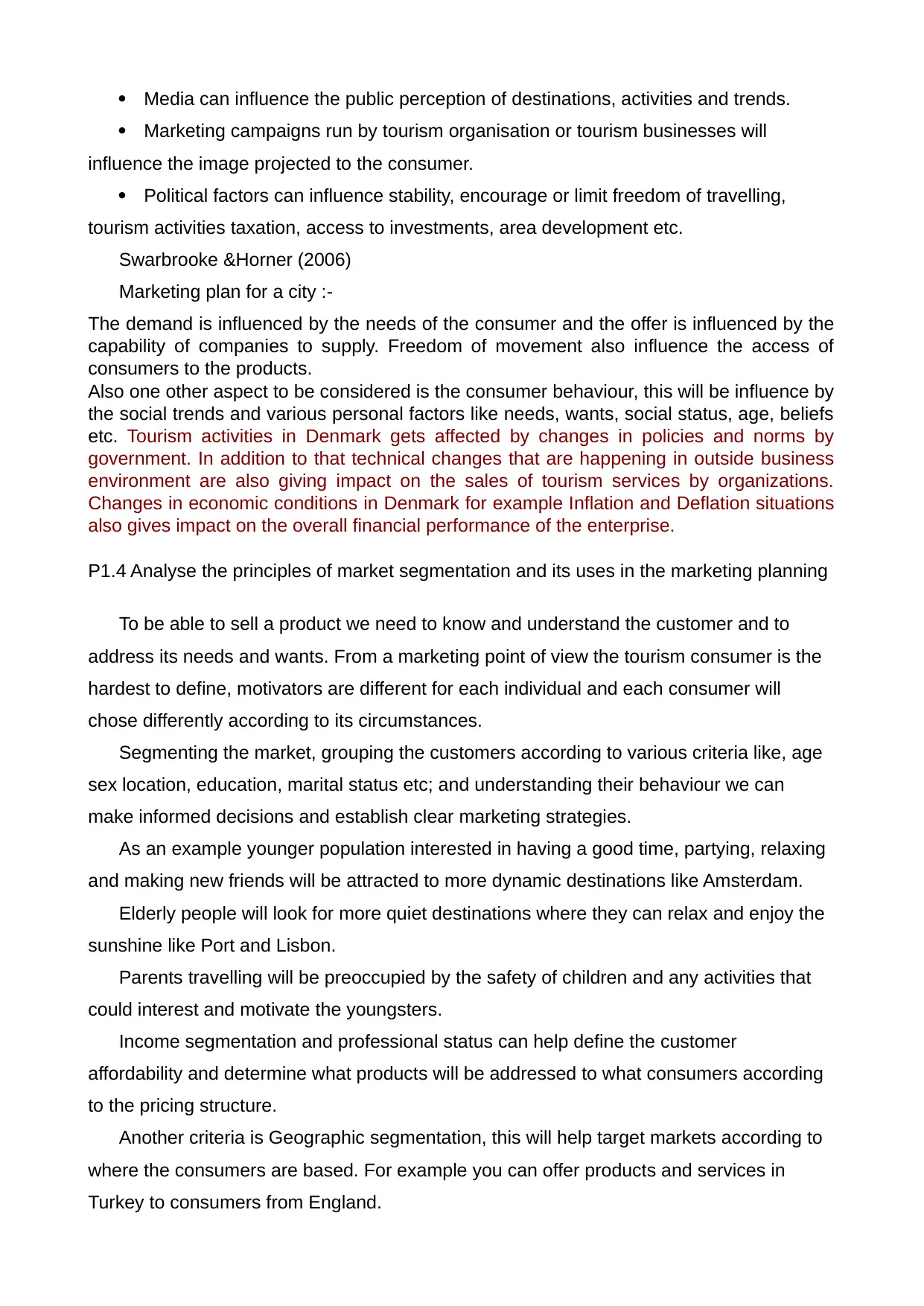
Media can influence the public perception of destinations, activities and trends.
Marketing campaigns run by tourism organisation or tourism businesses will
influence the image projected to the consumer.
Political factors can influence stability, encourage or limit freedom of travelling,
tourism activities taxation, access to investments, area development etc.
Swarbrooke &Horner (2006)
Marketing plan for a city :-
The demand is influenced by the needs of the consumer and the offer is influenced by the
capability of companies to supply. Freedom of movement also influence the access of
consumers to the products.
Also one other aspect to be considered is the consumer behaviour, this will be influence by
the social trends and various personal factors like needs, wants, social status, age, beliefs
etc. Tourism activities in Denmark gets affected by changes in policies and norms by
government. In addition to that technical changes that are happening in outside business
environment are also giving impact on the sales of tourism services by organizations.
Changes in economic conditions in Denmark for example Inflation and Deflation situations
also gives impact on the overall financial performance of the enterprise.
P1.4 Analyse the principles of market segmentation and its uses in the marketing planning
To be able to sell a product we need to know and understand the customer and to
address its needs and wants. From a marketing point of view the tourism consumer is the
hardest to define, motivators are different for each individual and each consumer will
chose differently according to its circumstances.
Segmenting the market, grouping the customers according to various criteria like, age
sex location, education, marital status etc; and understanding their behaviour we can
make informed decisions and establish clear marketing strategies.
As an example younger population interested in having a good time, partying, relaxing
and making new friends will be attracted to more dynamic destinations like Amsterdam.
Elderly people will look for more quiet destinations where they can relax and enjoy the
sunshine like Port and Lisbon.
Parents travelling will be preoccupied by the safety of children and any activities that
could interest and motivate the youngsters.
Income segmentation and professional status can help define the customer
affordability and determine what products will be addressed to what consumers according
to the pricing structure.
Another criteria is Geographic segmentation, this will help target markets according to
where the consumers are based. For example you can offer products and services in
Turkey to consumers from England.
Marketing campaigns run by tourism organisation or tourism businesses will
influence the image projected to the consumer.
Political factors can influence stability, encourage or limit freedom of travelling,
tourism activities taxation, access to investments, area development etc.
Swarbrooke &Horner (2006)
Marketing plan for a city :-
The demand is influenced by the needs of the consumer and the offer is influenced by the
capability of companies to supply. Freedom of movement also influence the access of
consumers to the products.
Also one other aspect to be considered is the consumer behaviour, this will be influence by
the social trends and various personal factors like needs, wants, social status, age, beliefs
etc. Tourism activities in Denmark gets affected by changes in policies and norms by
government. In addition to that technical changes that are happening in outside business
environment are also giving impact on the sales of tourism services by organizations.
Changes in economic conditions in Denmark for example Inflation and Deflation situations
also gives impact on the overall financial performance of the enterprise.
P1.4 Analyse the principles of market segmentation and its uses in the marketing planning
To be able to sell a product we need to know and understand the customer and to
address its needs and wants. From a marketing point of view the tourism consumer is the
hardest to define, motivators are different for each individual and each consumer will
chose differently according to its circumstances.
Segmenting the market, grouping the customers according to various criteria like, age
sex location, education, marital status etc; and understanding their behaviour we can
make informed decisions and establish clear marketing strategies.
As an example younger population interested in having a good time, partying, relaxing
and making new friends will be attracted to more dynamic destinations like Amsterdam.
Elderly people will look for more quiet destinations where they can relax and enjoy the
sunshine like Port and Lisbon.
Parents travelling will be preoccupied by the safety of children and any activities that
could interest and motivate the youngsters.
Income segmentation and professional status can help define the customer
affordability and determine what products will be addressed to what consumers according
to the pricing structure.
Another criteria is Geographic segmentation, this will help target markets according to
where the consumers are based. For example you can offer products and services in
Turkey to consumers from England.
⊘ This is a preview!⊘
Do you want full access?
Subscribe today to unlock all pages.

Trusted by 1+ million students worldwide
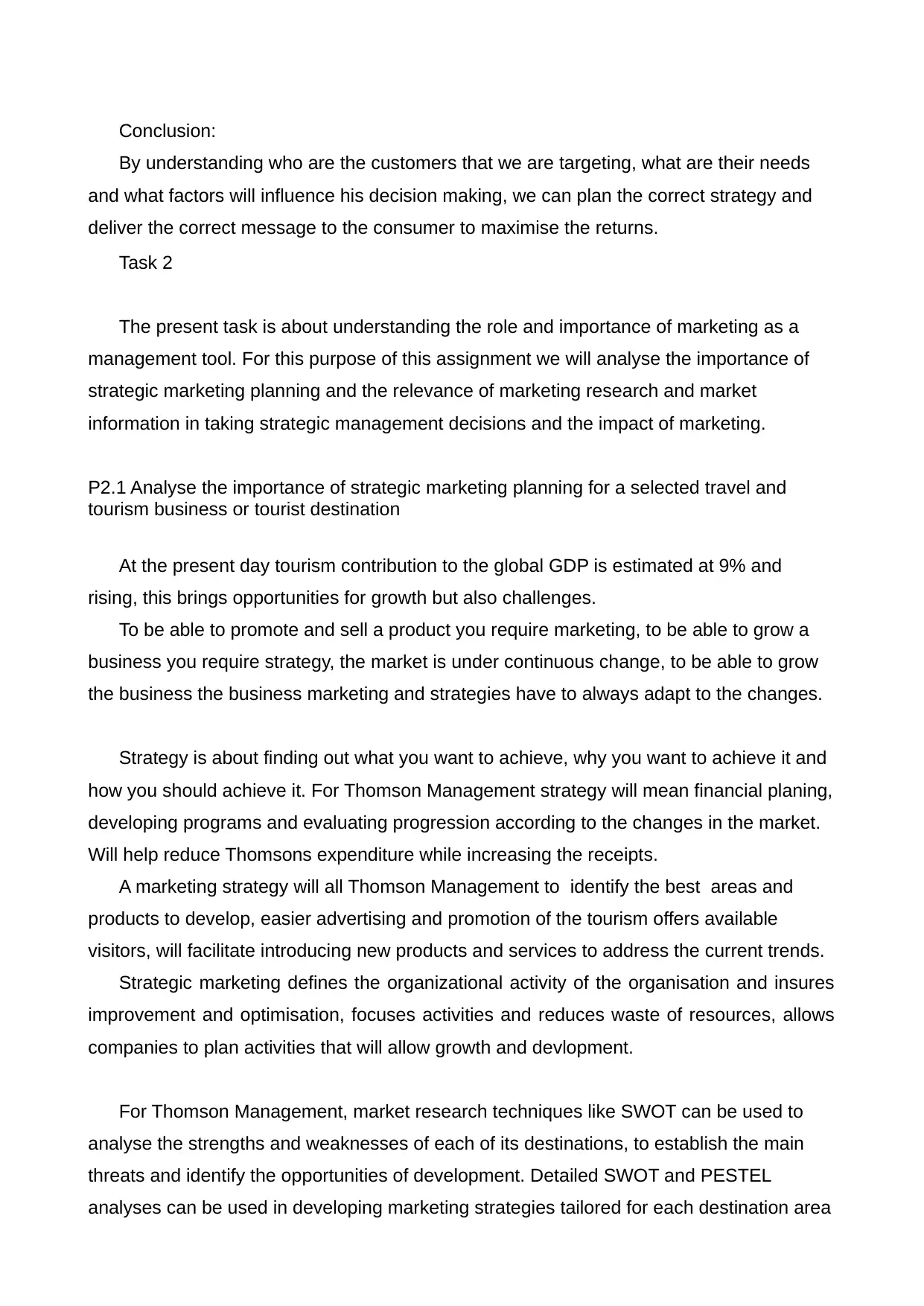
Conclusion:
By understanding who are the customers that we are targeting, what are their needs
and what factors will influence his decision making, we can plan the correct strategy and
deliver the correct message to the consumer to maximise the returns.
Task 2
The present task is about understanding the role and importance of marketing as a
management tool. For this purpose of this assignment we will analyse the importance of
strategic marketing planning and the relevance of marketing research and market
information in taking strategic management decisions and the impact of marketing.
P2.1 Analyse the importance of strategic marketing planning for a selected travel and
tourism business or tourist destination
At the present day tourism contribution to the global GDP is estimated at 9% and
rising, this brings opportunities for growth but also challenges.
To be able to promote and sell a product you require marketing, to be able to grow a
business you require strategy, the market is under continuous change, to be able to grow
the business the business marketing and strategies have to always adapt to the changes.
Strategy is about finding out what you want to achieve, why you want to achieve it and
how you should achieve it. For Thomson Management strategy will mean financial planing,
developing programs and evaluating progression according to the changes in the market.
Will help reduce Thomsons expenditure while increasing the receipts.
A marketing strategy will all Thomson Management to identify the best areas and
products to develop, easier advertising and promotion of the tourism offers available
visitors, will facilitate introducing new products and services to address the current trends.
Strategic marketing defines the organizational activity of the organisation and insures
improvement and optimisation, focuses activities and reduces waste of resources, allows
companies to plan activities that will allow growth and devlopment.
For Thomson Management, market research techniques like SWOT can be used to
analyse the strengths and weaknesses of each of its destinations, to establish the main
threats and identify the opportunities of development. Detailed SWOT and PESTEL
analyses can be used in developing marketing strategies tailored for each destination area
By understanding who are the customers that we are targeting, what are their needs
and what factors will influence his decision making, we can plan the correct strategy and
deliver the correct message to the consumer to maximise the returns.
Task 2
The present task is about understanding the role and importance of marketing as a
management tool. For this purpose of this assignment we will analyse the importance of
strategic marketing planning and the relevance of marketing research and market
information in taking strategic management decisions and the impact of marketing.
P2.1 Analyse the importance of strategic marketing planning for a selected travel and
tourism business or tourist destination
At the present day tourism contribution to the global GDP is estimated at 9% and
rising, this brings opportunities for growth but also challenges.
To be able to promote and sell a product you require marketing, to be able to grow a
business you require strategy, the market is under continuous change, to be able to grow
the business the business marketing and strategies have to always adapt to the changes.
Strategy is about finding out what you want to achieve, why you want to achieve it and
how you should achieve it. For Thomson Management strategy will mean financial planing,
developing programs and evaluating progression according to the changes in the market.
Will help reduce Thomsons expenditure while increasing the receipts.
A marketing strategy will all Thomson Management to identify the best areas and
products to develop, easier advertising and promotion of the tourism offers available
visitors, will facilitate introducing new products and services to address the current trends.
Strategic marketing defines the organizational activity of the organisation and insures
improvement and optimisation, focuses activities and reduces waste of resources, allows
companies to plan activities that will allow growth and devlopment.
For Thomson Management, market research techniques like SWOT can be used to
analyse the strengths and weaknesses of each of its destinations, to establish the main
threats and identify the opportunities of development. Detailed SWOT and PESTEL
analyses can be used in developing marketing strategies tailored for each destination area
Paraphrase This Document
Need a fresh take? Get an instant paraphrase of this document with our AI Paraphraser
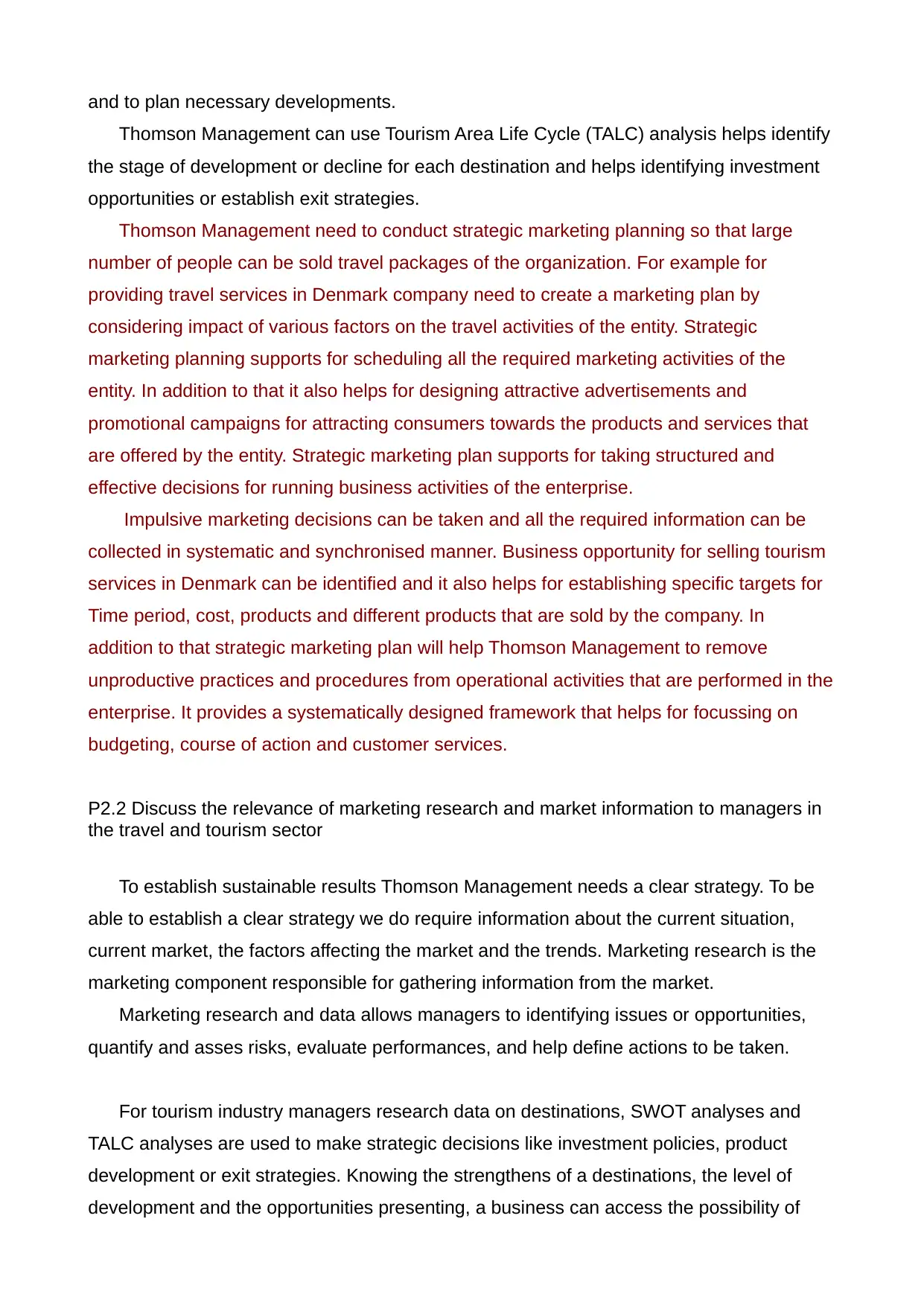
and to plan necessary developments.
Thomson Management can use Tourism Area Life Cycle (TALC) analysis helps identify
the stage of development or decline for each destination and helps identifying investment
opportunities or establish exit strategies.
Thomson Management need to conduct strategic marketing planning so that large
number of people can be sold travel packages of the organization. For example for
providing travel services in Denmark company need to create a marketing plan by
considering impact of various factors on the travel activities of the entity. Strategic
marketing planning supports for scheduling all the required marketing activities of the
entity. In addition to that it also helps for designing attractive advertisements and
promotional campaigns for attracting consumers towards the products and services that
are offered by the entity. Strategic marketing plan supports for taking structured and
effective decisions for running business activities of the enterprise.
Impulsive marketing decisions can be taken and all the required information can be
collected in systematic and synchronised manner. Business opportunity for selling tourism
services in Denmark can be identified and it also helps for establishing specific targets for
Time period, cost, products and different products that are sold by the company. In
addition to that strategic marketing plan will help Thomson Management to remove
unproductive practices and procedures from operational activities that are performed in the
enterprise. It provides a systematically designed framework that helps for focussing on
budgeting, course of action and customer services.
P2.2 Discuss the relevance of marketing research and market information to managers in
the travel and tourism sector
To establish sustainable results Thomson Management needs a clear strategy. To be
able to establish a clear strategy we do require information about the current situation,
current market, the factors affecting the market and the trends. Marketing research is the
marketing component responsible for gathering information from the market.
Marketing research and data allows managers to identifying issues or opportunities,
quantify and asses risks, evaluate performances, and help define actions to be taken.
For tourism industry managers research data on destinations, SWOT analyses and
TALC analyses are used to make strategic decisions like investment policies, product
development or exit strategies. Knowing the strengthens of a destinations, the level of
development and the opportunities presenting, a business can access the possibility of
Thomson Management can use Tourism Area Life Cycle (TALC) analysis helps identify
the stage of development or decline for each destination and helps identifying investment
opportunities or establish exit strategies.
Thomson Management need to conduct strategic marketing planning so that large
number of people can be sold travel packages of the organization. For example for
providing travel services in Denmark company need to create a marketing plan by
considering impact of various factors on the travel activities of the entity. Strategic
marketing planning supports for scheduling all the required marketing activities of the
entity. In addition to that it also helps for designing attractive advertisements and
promotional campaigns for attracting consumers towards the products and services that
are offered by the entity. Strategic marketing plan supports for taking structured and
effective decisions for running business activities of the enterprise.
Impulsive marketing decisions can be taken and all the required information can be
collected in systematic and synchronised manner. Business opportunity for selling tourism
services in Denmark can be identified and it also helps for establishing specific targets for
Time period, cost, products and different products that are sold by the company. In
addition to that strategic marketing plan will help Thomson Management to remove
unproductive practices and procedures from operational activities that are performed in the
enterprise. It provides a systematically designed framework that helps for focussing on
budgeting, course of action and customer services.
P2.2 Discuss the relevance of marketing research and market information to managers in
the travel and tourism sector
To establish sustainable results Thomson Management needs a clear strategy. To be
able to establish a clear strategy we do require information about the current situation,
current market, the factors affecting the market and the trends. Marketing research is the
marketing component responsible for gathering information from the market.
Marketing research and data allows managers to identifying issues or opportunities,
quantify and asses risks, evaluate performances, and help define actions to be taken.
For tourism industry managers research data on destinations, SWOT analyses and
TALC analyses are used to make strategic decisions like investment policies, product
development or exit strategies. Knowing the strengthens of a destinations, the level of
development and the opportunities presenting, a business can access the possibility of
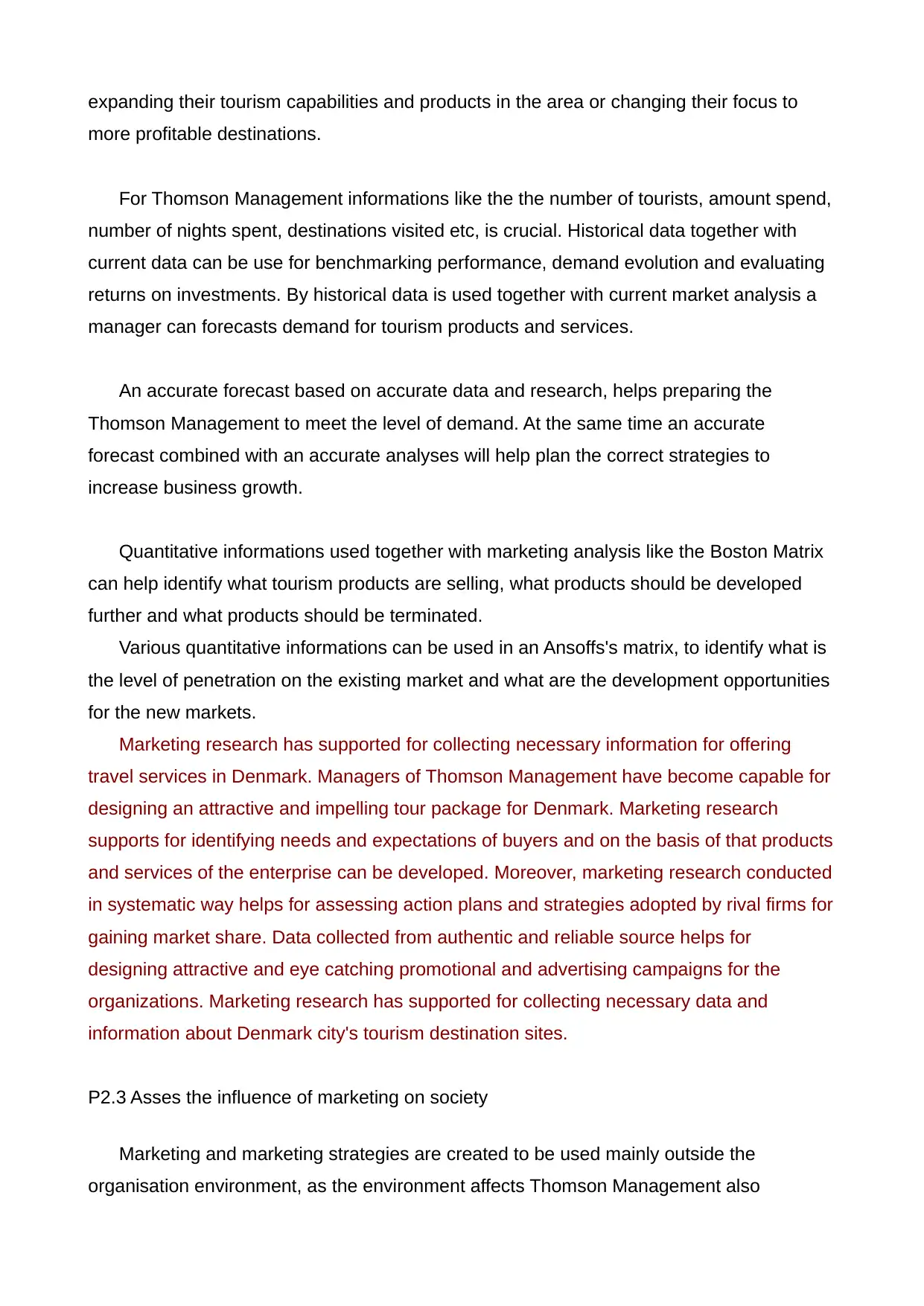
expanding their tourism capabilities and products in the area or changing their focus to
more profitable destinations.
For Thomson Management informations like the the number of tourists, amount spend,
number of nights spent, destinations visited etc, is crucial. Historical data together with
current data can be use for benchmarking performance, demand evolution and evaluating
returns on investments. By historical data is used together with current market analysis a
manager can forecasts demand for tourism products and services.
An accurate forecast based on accurate data and research, helps preparing the
Thomson Management to meet the level of demand. At the same time an accurate
forecast combined with an accurate analyses will help plan the correct strategies to
increase business growth.
Quantitative informations used together with marketing analysis like the Boston Matrix
can help identify what tourism products are selling, what products should be developed
further and what products should be terminated.
Various quantitative informations can be used in an Ansoffs's matrix, to identify what is
the level of penetration on the existing market and what are the development opportunities
for the new markets.
Marketing research has supported for collecting necessary information for offering
travel services in Denmark. Managers of Thomson Management have become capable for
designing an attractive and impelling tour package for Denmark. Marketing research
supports for identifying needs and expectations of buyers and on the basis of that products
and services of the enterprise can be developed. Moreover, marketing research conducted
in systematic way helps for assessing action plans and strategies adopted by rival firms for
gaining market share. Data collected from authentic and reliable source helps for
designing attractive and eye catching promotional and advertising campaigns for the
organizations. Marketing research has supported for collecting necessary data and
information about Denmark city's tourism destination sites.
P2.3 Asses the influence of marketing on society
Marketing and marketing strategies are created to be used mainly outside the
organisation environment, as the environment affects Thomson Management also
more profitable destinations.
For Thomson Management informations like the the number of tourists, amount spend,
number of nights spent, destinations visited etc, is crucial. Historical data together with
current data can be use for benchmarking performance, demand evolution and evaluating
returns on investments. By historical data is used together with current market analysis a
manager can forecasts demand for tourism products and services.
An accurate forecast based on accurate data and research, helps preparing the
Thomson Management to meet the level of demand. At the same time an accurate
forecast combined with an accurate analyses will help plan the correct strategies to
increase business growth.
Quantitative informations used together with marketing analysis like the Boston Matrix
can help identify what tourism products are selling, what products should be developed
further and what products should be terminated.
Various quantitative informations can be used in an Ansoffs's matrix, to identify what is
the level of penetration on the existing market and what are the development opportunities
for the new markets.
Marketing research has supported for collecting necessary information for offering
travel services in Denmark. Managers of Thomson Management have become capable for
designing an attractive and impelling tour package for Denmark. Marketing research
supports for identifying needs and expectations of buyers and on the basis of that products
and services of the enterprise can be developed. Moreover, marketing research conducted
in systematic way helps for assessing action plans and strategies adopted by rival firms for
gaining market share. Data collected from authentic and reliable source helps for
designing attractive and eye catching promotional and advertising campaigns for the
organizations. Marketing research has supported for collecting necessary data and
information about Denmark city's tourism destination sites.
P2.3 Asses the influence of marketing on society
Marketing and marketing strategies are created to be used mainly outside the
organisation environment, as the environment affects Thomson Management also
⊘ This is a preview!⊘
Do you want full access?
Subscribe today to unlock all pages.

Trusted by 1+ million students worldwide
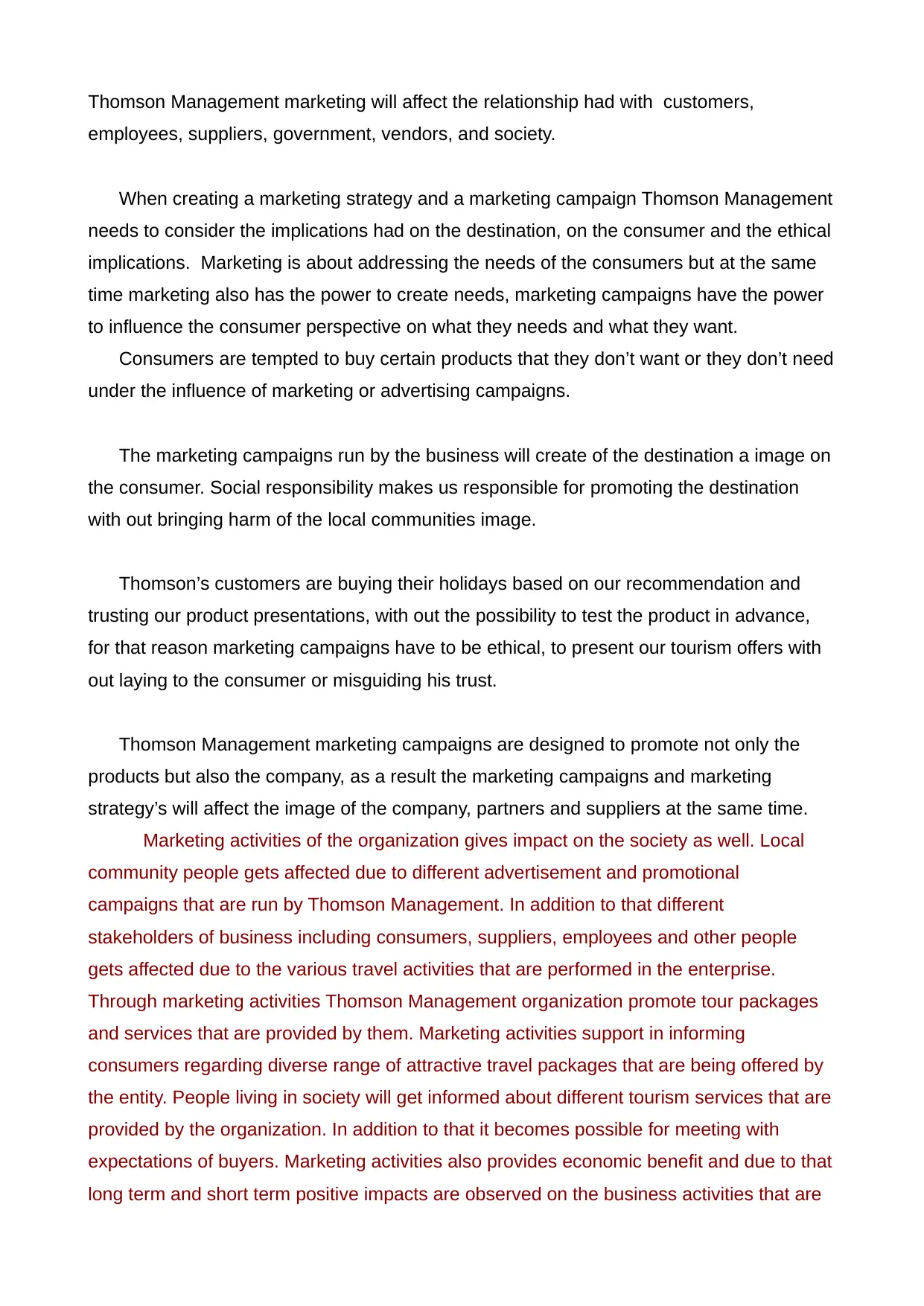
Thomson Management marketing will affect the relationship had with customers,
employees, suppliers, government, vendors, and society.
When creating a marketing strategy and a marketing campaign Thomson Management
needs to consider the implications had on the destination, on the consumer and the ethical
implications. Marketing is about addressing the needs of the consumers but at the same
time marketing also has the power to create needs, marketing campaigns have the power
to influence the consumer perspective on what they needs and what they want.
Consumers are tempted to buy certain products that they don’t want or they don’t need
under the influence of marketing or advertising campaigns.
The marketing campaigns run by the business will create of the destination a image on
the consumer. Social responsibility makes us responsible for promoting the destination
with out bringing harm of the local communities image.
Thomson’s customers are buying their holidays based on our recommendation and
trusting our product presentations, with out the possibility to test the product in advance,
for that reason marketing campaigns have to be ethical, to present our tourism offers with
out laying to the consumer or misguiding his trust.
Thomson Management marketing campaigns are designed to promote not only the
products but also the company, as a result the marketing campaigns and marketing
strategy’s will affect the image of the company, partners and suppliers at the same time.
Marketing activities of the organization gives impact on the society as well. Local
community people gets affected due to different advertisement and promotional
campaigns that are run by Thomson Management. In addition to that different
stakeholders of business including consumers, suppliers, employees and other people
gets affected due to the various travel activities that are performed in the enterprise.
Through marketing activities Thomson Management organization promote tour packages
and services that are provided by them. Marketing activities support in informing
consumers regarding diverse range of attractive travel packages that are being offered by
the entity. People living in society will get informed about different tourism services that are
provided by the organization. In addition to that it becomes possible for meeting with
expectations of buyers. Marketing activities also provides economic benefit and due to that
long term and short term positive impacts are observed on the business activities that are
employees, suppliers, government, vendors, and society.
When creating a marketing strategy and a marketing campaign Thomson Management
needs to consider the implications had on the destination, on the consumer and the ethical
implications. Marketing is about addressing the needs of the consumers but at the same
time marketing also has the power to create needs, marketing campaigns have the power
to influence the consumer perspective on what they needs and what they want.
Consumers are tempted to buy certain products that they don’t want or they don’t need
under the influence of marketing or advertising campaigns.
The marketing campaigns run by the business will create of the destination a image on
the consumer. Social responsibility makes us responsible for promoting the destination
with out bringing harm of the local communities image.
Thomson’s customers are buying their holidays based on our recommendation and
trusting our product presentations, with out the possibility to test the product in advance,
for that reason marketing campaigns have to be ethical, to present our tourism offers with
out laying to the consumer or misguiding his trust.
Thomson Management marketing campaigns are designed to promote not only the
products but also the company, as a result the marketing campaigns and marketing
strategy’s will affect the image of the company, partners and suppliers at the same time.
Marketing activities of the organization gives impact on the society as well. Local
community people gets affected due to different advertisement and promotional
campaigns that are run by Thomson Management. In addition to that different
stakeholders of business including consumers, suppliers, employees and other people
gets affected due to the various travel activities that are performed in the enterprise.
Through marketing activities Thomson Management organization promote tour packages
and services that are provided by them. Marketing activities support in informing
consumers regarding diverse range of attractive travel packages that are being offered by
the entity. People living in society will get informed about different tourism services that are
provided by the organization. In addition to that it becomes possible for meeting with
expectations of buyers. Marketing activities also provides economic benefit and due to that
long term and short term positive impacts are observed on the business activities that are
Paraphrase This Document
Need a fresh take? Get an instant paraphrase of this document with our AI Paraphraser
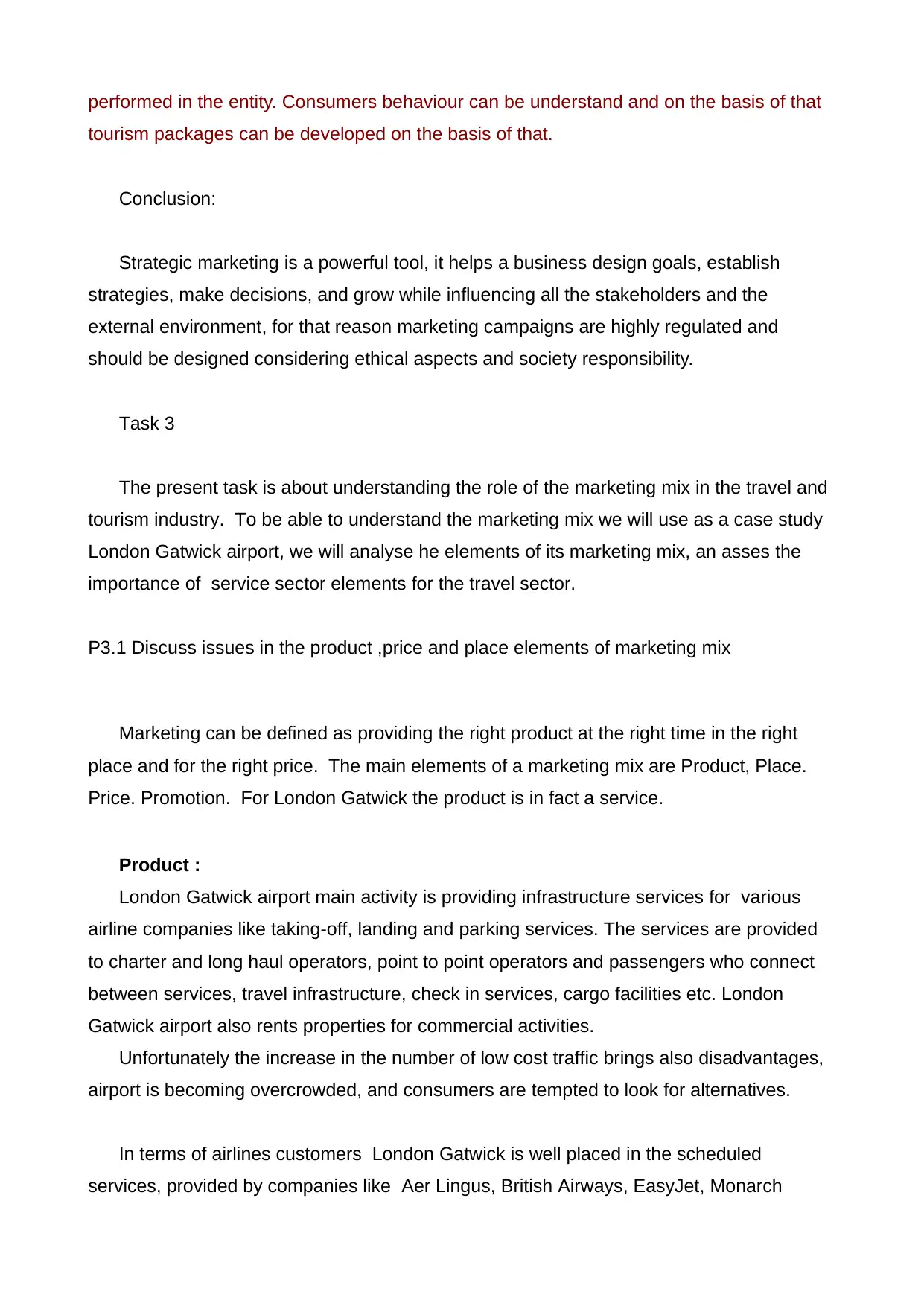
performed in the entity. Consumers behaviour can be understand and on the basis of that
tourism packages can be developed on the basis of that.
Conclusion:
Strategic marketing is a powerful tool, it helps a business design goals, establish
strategies, make decisions, and grow while influencing all the stakeholders and the
external environment, for that reason marketing campaigns are highly regulated and
should be designed considering ethical aspects and society responsibility.
Task 3
The present task is about understanding the role of the marketing mix in the travel and
tourism industry. To be able to understand the marketing mix we will use as a case study
London Gatwick airport, we will analyse he elements of its marketing mix, an asses the
importance of service sector elements for the travel sector.
P3.1 Discuss issues in the product ,price and place elements of marketing mix
Marketing can be defined as providing the right product at the right time in the right
place and for the right price. The main elements of a marketing mix are Product, Place.
Price. Promotion. For London Gatwick the product is in fact a service.
Product :
London Gatwick airport main activity is providing infrastructure services for various
airline companies like taking-off, landing and parking services. The services are provided
to charter and long haul operators, point to point operators and passengers who connect
between services, travel infrastructure, check in services, cargo facilities etc. London
Gatwick airport also rents properties for commercial activities.
Unfortunately the increase in the number of low cost traffic brings also disadvantages,
airport is becoming overcrowded, and consumers are tempted to look for alternatives.
In terms of airlines customers London Gatwick is well placed in the scheduled
services, provided by companies like Aer Lingus, British Airways, EasyJet, Monarch
tourism packages can be developed on the basis of that.
Conclusion:
Strategic marketing is a powerful tool, it helps a business design goals, establish
strategies, make decisions, and grow while influencing all the stakeholders and the
external environment, for that reason marketing campaigns are highly regulated and
should be designed considering ethical aspects and society responsibility.
Task 3
The present task is about understanding the role of the marketing mix in the travel and
tourism industry. To be able to understand the marketing mix we will use as a case study
London Gatwick airport, we will analyse he elements of its marketing mix, an asses the
importance of service sector elements for the travel sector.
P3.1 Discuss issues in the product ,price and place elements of marketing mix
Marketing can be defined as providing the right product at the right time in the right
place and for the right price. The main elements of a marketing mix are Product, Place.
Price. Promotion. For London Gatwick the product is in fact a service.
Product :
London Gatwick airport main activity is providing infrastructure services for various
airline companies like taking-off, landing and parking services. The services are provided
to charter and long haul operators, point to point operators and passengers who connect
between services, travel infrastructure, check in services, cargo facilities etc. London
Gatwick airport also rents properties for commercial activities.
Unfortunately the increase in the number of low cost traffic brings also disadvantages,
airport is becoming overcrowded, and consumers are tempted to look for alternatives.
In terms of airlines customers London Gatwick is well placed in the scheduled
services, provided by companies like Aer Lingus, British Airways, EasyJet, Monarch
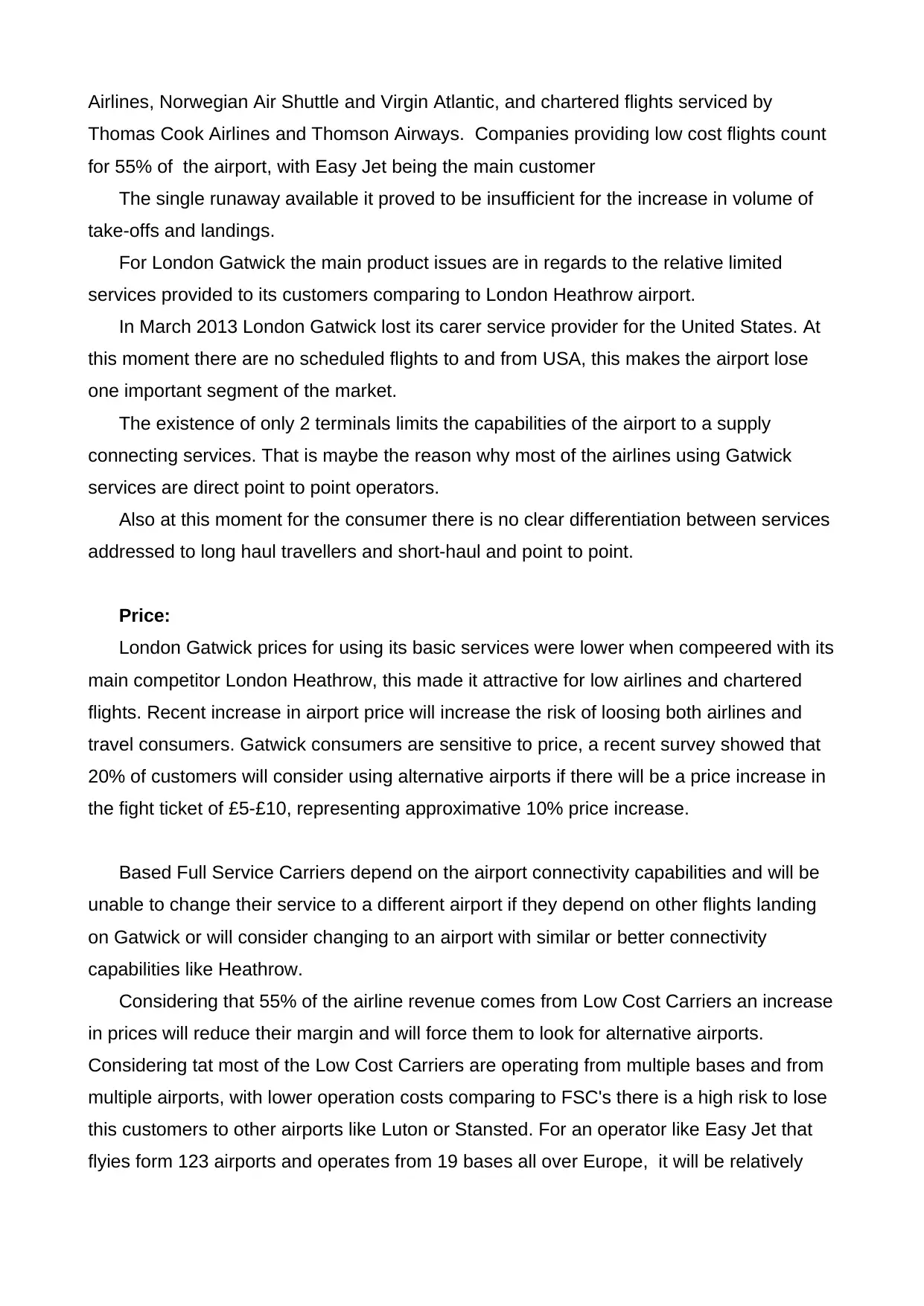
Airlines, Norwegian Air Shuttle and Virgin Atlantic, and chartered flights serviced by
Thomas Cook Airlines and Thomson Airways. Companies providing low cost flights count
for 55% of the airport, with Easy Jet being the main customer
The single runaway available it proved to be insufficient for the increase in volume of
take-offs and landings.
For London Gatwick the main product issues are in regards to the relative limited
services provided to its customers comparing to London Heathrow airport.
In March 2013 London Gatwick lost its carer service provider for the United States. At
this moment there are no scheduled flights to and from USA, this makes the airport lose
one important segment of the market.
The existence of only 2 terminals limits the capabilities of the airport to a supply
connecting services. That is maybe the reason why most of the airlines using Gatwick
services are direct point to point operators.
Also at this moment for the consumer there is no clear differentiation between services
addressed to long haul travellers and short-haul and point to point.
Price:
London Gatwick prices for using its basic services were lower when compeered with its
main competitor London Heathrow, this made it attractive for low airlines and chartered
flights. Recent increase in airport price will increase the risk of loosing both airlines and
travel consumers. Gatwick consumers are sensitive to price, a recent survey showed that
20% of customers will consider using alternative airports if there will be a price increase in
the fight ticket of £5-£10, representing approximative 10% price increase.
Based Full Service Carriers depend on the airport connectivity capabilities and will be
unable to change their service to a different airport if they depend on other flights landing
on Gatwick or will consider changing to an airport with similar or better connectivity
capabilities like Heathrow.
Considering that 55% of the airline revenue comes from Low Cost Carriers an increase
in prices will reduce their margin and will force them to look for alternative airports.
Considering tat most of the Low Cost Carriers are operating from multiple bases and from
multiple airports, with lower operation costs comparing to FSC's there is a high risk to lose
this customers to other airports like Luton or Stansted. For an operator like Easy Jet that
flyies form 123 airports and operates from 19 bases all over Europe, it will be relatively
Thomas Cook Airlines and Thomson Airways. Companies providing low cost flights count
for 55% of the airport, with Easy Jet being the main customer
The single runaway available it proved to be insufficient for the increase in volume of
take-offs and landings.
For London Gatwick the main product issues are in regards to the relative limited
services provided to its customers comparing to London Heathrow airport.
In March 2013 London Gatwick lost its carer service provider for the United States. At
this moment there are no scheduled flights to and from USA, this makes the airport lose
one important segment of the market.
The existence of only 2 terminals limits the capabilities of the airport to a supply
connecting services. That is maybe the reason why most of the airlines using Gatwick
services are direct point to point operators.
Also at this moment for the consumer there is no clear differentiation between services
addressed to long haul travellers and short-haul and point to point.
Price:
London Gatwick prices for using its basic services were lower when compeered with its
main competitor London Heathrow, this made it attractive for low airlines and chartered
flights. Recent increase in airport price will increase the risk of loosing both airlines and
travel consumers. Gatwick consumers are sensitive to price, a recent survey showed that
20% of customers will consider using alternative airports if there will be a price increase in
the fight ticket of £5-£10, representing approximative 10% price increase.
Based Full Service Carriers depend on the airport connectivity capabilities and will be
unable to change their service to a different airport if they depend on other flights landing
on Gatwick or will consider changing to an airport with similar or better connectivity
capabilities like Heathrow.
Considering that 55% of the airline revenue comes from Low Cost Carriers an increase
in prices will reduce their margin and will force them to look for alternative airports.
Considering tat most of the Low Cost Carriers are operating from multiple bases and from
multiple airports, with lower operation costs comparing to FSC's there is a high risk to lose
this customers to other airports like Luton or Stansted. For an operator like Easy Jet that
flyies form 123 airports and operates from 19 bases all over Europe, it will be relatively
⊘ This is a preview!⊘
Do you want full access?
Subscribe today to unlock all pages.

Trusted by 1+ million students worldwide
1 out of 18
Related Documents
Your All-in-One AI-Powered Toolkit for Academic Success.
+13062052269
info@desklib.com
Available 24*7 on WhatsApp / Email
![[object Object]](/_next/static/media/star-bottom.7253800d.svg)
Unlock your academic potential
Copyright © 2020–2025 A2Z Services. All Rights Reserved. Developed and managed by ZUCOL.





